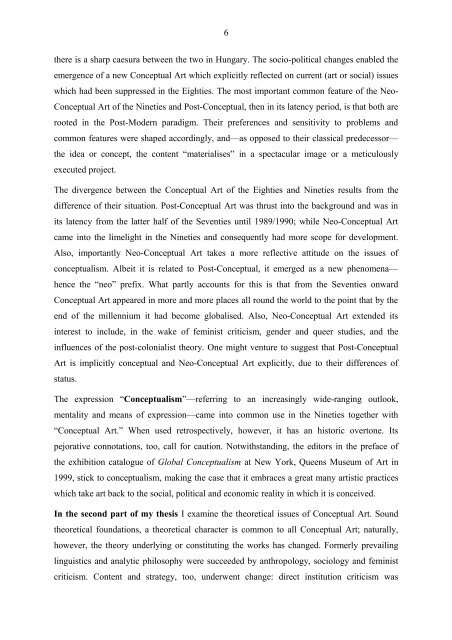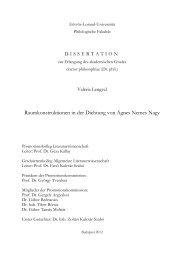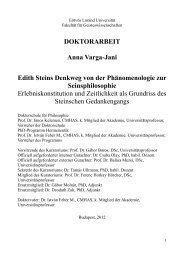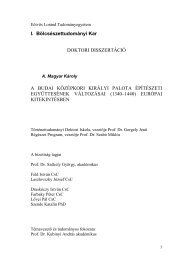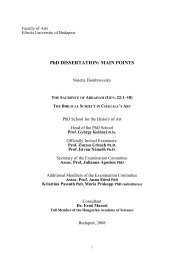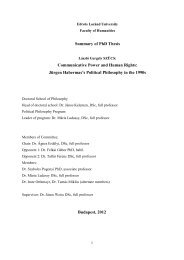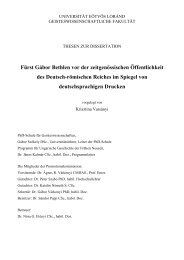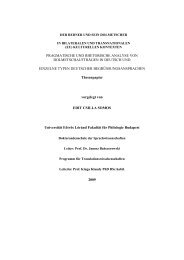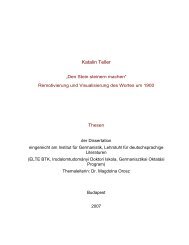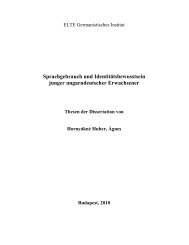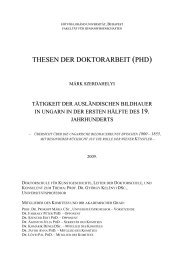eötvös loránd university faculty of humanities - ELTE BTK disszertációk
eötvös loránd university faculty of humanities - ELTE BTK disszertációk
eötvös loránd university faculty of humanities - ELTE BTK disszertációk
You also want an ePaper? Increase the reach of your titles
YUMPU automatically turns print PDFs into web optimized ePapers that Google loves.
there is a sharp caesura between the two in Hungary. The socio-political changes enabled the<br />
emergence <strong>of</strong> a new Conceptual Art which explicitly reflected on current (art or social) issues<br />
which had been suppressed in the Eighties. The most important common feature <strong>of</strong> the Neo-<br />
Conceptual Art <strong>of</strong> the Nineties and Post-Conceptual, then in its latency period, is that both are<br />
rooted in the Post-Modern paradigm. Their preferences and sensitivity to problems and<br />
common features were shaped accordingly, and—as opposed to their classical predecessor—<br />
the idea or concept, the content “materialises” in a spectacular image or a meticulously<br />
executed project.<br />
The divergence between the Conceptual Art <strong>of</strong> the Eighties and Nineties results from the<br />
difference <strong>of</strong> their situation. Post-Conceptual Art was thrust into the background and was in<br />
its latency from the latter half <strong>of</strong> the Seventies until 1989/1990; while Neo-Conceptual Art<br />
came into the limelight in the Nineties and consequently had more scope for development.<br />
Also, importantly Neo-Conceptual Art takes a more reflective attitude on the issues <strong>of</strong><br />
conceptualism. Albeit it is related to Post-Conceptual, it emerged as a new phenomena—<br />
hence the “neo” prefix. What partly accounts for this is that from the Seventies onward<br />
Conceptual Art appeared in more and more places all round the world to the point that by the<br />
end <strong>of</strong> the millennium it had become globalised. Also, Neo-Conceptual Art extended its<br />
interest to include, in the wake <strong>of</strong> feminist criticism, gender and queer studies, and the<br />
influences <strong>of</strong> the post-colonialist theory. One might venture to suggest that Post-Conceptual<br />
Art is implicitly conceptual and Neo-Conceptual Art explicitly, due to their differences <strong>of</strong><br />
status.<br />
The expression “Conceptualism”—referring to an increasingly wide-ranging outlook,<br />
mentality and means <strong>of</strong> expression—came into common use in the Nineties together with<br />
“Conceptual Art.” When used retrospectively, however, it has an historic overtone. Its<br />
pejorative connotations, too, call for caution. Notwithstanding, the editors in the preface <strong>of</strong><br />
the exhibition catalogue <strong>of</strong> Global Conceptualism at New York, Queens Museum <strong>of</strong> Art in<br />
1999, stick to conceptualism, making the case that it embraces a great many artistic practices<br />
which take art back to the social, political and economic reality in which it is conceived.<br />
6<br />
In the second part <strong>of</strong> my thesis I examine the theoretical issues <strong>of</strong> Conceptual Art. Sound<br />
theoretical foundations, a theoretical character is common to all Conceptual Art; naturally,<br />
however, the theory underlying or constituting the works has changed. Formerly prevailing<br />
linguistics and analytic philosophy were succeeded by anthropology, sociology and feminist<br />
criticism. Content and strategy, too, underwent change: direct institution criticism was


